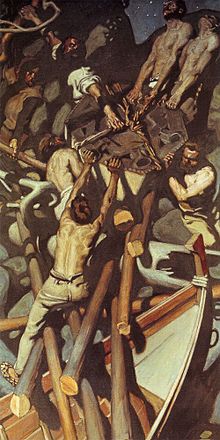Sampo

InFinnish mythology,theSampo(pronounced[ˈsɑmpo])[1]is a magical device or object described in many different ways that was constructed by the blacksmithIlmarinenand that brought riches and good fortune to its holder, akin to thehorn of plenty(cornucopia) of Greek mythology. When the Sampo was stolen, Ilmarinen's homeland fell upon hard times. He sent an expedition to retrieve it, but in the ensuing battle it was smashed and lost at sea.
In the Kalevala
[edit]The Sampo is a pivotal element of the plot of the Finnish epic poemKalevala,compiled in 1835 (and expanded in 1849) byElias Lönnrotbased on Finnishoral tradition.
In the expanded second version of the poem, the Sampo is forged byIlmarinen,a legendarysmith,to fulfill a task set by the witch queen ofPohjola,Louhi,in return for her daughter's hand.
- "Ilmarinen, worthy brother,
- Thou the only skilful blacksmith,
- Go and see her wondrous beauty,
- See her gold and silver garments,
- See her robed in finest raiment,
- See her sitting on the rainbow,
- Walking on the clouds of purple.
- Forge for her the magic Sampo,
- Forge the lid in many colors,
- Thy reward shall be the virgin,
- Thou shalt win this bride of beauty;
- Go and bring the lovely maiden
- To thy home in Kalevala. "[2]
-
Ilmarinen Forges the Sampo,Berndt Godenhjelm,19th century
-
The Forging of the Sampo,Väinö Blomstedt,1897
-
The Forging of the Sampo,Akseli Gallen-Kallela, 1893
-
The Forging of the Sampo,Joseph Alanen,1910–1911
-
The Forging of the Sampo,frescoin theNational Museum of Finlandby Akseli Gallen-Kallela, 1928
Ilmarinen works for many days at a mighty forge until he finally succeeds in creating the Sampo:
- On one side the flour is grinding,
- On another salt is making,
- On a third is money forging,
- And the lid is many-colored.
- Well the Sampo grinds when finished,
- To and fro the lid in rocking,
- Grinds one measure at the day-break,
- Grinds a measure fit for eating,
- Grinds a second for the market,
- Grinds a third one for the store-house.[2]
Later,Louhisteals the Sampo, and then Ilmarinen andVäinämöinenenter her stronghold in secret and retrieve it. Louhi pursues them and combats Väinämöinen. In the struggle, Louhi is vanquished but the Sampo is destroyed.
Interpretation
[edit]The Sampo has been interpreted in many ways: aworld pillarorworld tree,acompassorastrolabe,a chest containing a treasure, aByzantinecoin die,a decoratedVendel periodshield, a Christianrelic,etc. In theKalevala,compilerLönnrotinterpreted it to be aquernormillof some sort that madeflour,salt,andgoldout of thin air. The world pillar/tree hypothesis was argued for by figures such astheosophianPekka Ervast,historian of religionsUno Harvaand the linguistEemil Nestor Setäläin the early 20th century.[3]
According to the archaeologist Elena Kuz'mina the Sampo mill myth originates from theIndo-Europeanskambhá(support, pillar, column), and was borrowed intoFinno-Ugric.[4]In theAtharvavedathe 'skambhá' is a creature that supports the universe, analogous to theWorld Tree– the Sampo has been claimed to be the Finnish equivalent of the world tree.[4][5]
Similar devices
[edit]In theAarne–Thompson classification systemsof folktales, tale type 565 refers to a magic mill that continuously produces food or salt.[6]Examples includeWhy the Sea is Salt(Norway, based on the poemGrottasöngr),Sweet porridge(Germanic), andThe Water Mother(Chinese). Such devices have been included into modern tales such asStrega Nona(1975, children's book). Variants on the theme with a cautionary tale and pupil-master relationship includeThe Master and his Pupil(English), and Goethe's 1797 poemThe Sorcerer's Apprentice.
ThecornucopiaofGreek mythologyalso produces endless goods, and some versions of theGrail mythemphasize how the Grail creates food and goods.
TheJapanese folktaleShiofuki ususpeaks of a grindstone that could be used to create anything. Like the Sampo, it too was lost to the sea, endlessly grinding salt.
The Sanskrit epic theMahabharathatells of theAkshaya Patra,a vessel or bowl capable of creating food that stops at the end of the day when the lady of the house has had her last meal. Similarly, in the Irish myth of theCauldron of the Dagda(coire ansicor "un-dry cauldron" ) is a magical vessel that satisfies any number of people.
Influences
[edit]- The 1959 Soviet-Finnish filmSampois loosely based on the story.
- The Finnish TV seriesRauta-aika(The Iron Age, 1982), based on Kalevala, has an extended sequence where Ilmarinen and his smiths build the Sampo, which is a Byzantine coin die.
- InThe Quest for Kalevala,aDonald Duckstory byDisneycartoonistDon Rosabased on theKalevala,Scrooge McDuck,Donald Duck andHuey, Dewey, and Louietravel to Finland trying to reveal the location of the remains of the Sampo, a mythical machine that can producegold.[7]
- In 1933, A. A. Öpik named a genus of fossilbrachiopodSampo.[8]
- Asteroid2091 Sampois named after the artifact.
- The Finnish heavy metal bandAmorphishas a song calledSampoon their 2009 albumSkyforger.
- The Finnish symphonic power metal bandAmberian Dawnhas a song calledSampoon their 2010 albumEnd of Eden.
- The Semantic Computing Group atAalto Universityhas usedSampoas a generic name for their cultural heritage Web services, most recentlyBiographySampo(2018).[9]
See also
[edit]References
[edit]- ^Sometimes known asSammas(pronounced[ˈsɑmːɑs]) orKirjokansi(pronounced[ˈkirjoˌkɑnsi])
- ^abKalevala, Rune XArchived3 December 2005 at theWayback Machine.Translated by John Martin Crawford (1888).
- ^Heikura, Pasi (23 September 2014)."Aristoteleen kantapää ja Sammon selitykset".Yle.Archivedfrom the original on 6 July 2020.Retrieved6 July2020.
- ^abKuz'mina, Elena E. (2007). Mallory, J.P. (ed.).The origin of the Indo-Iranians.Vol. 3. Brill. pp.56.ISBN9789004160545.
{{cite book}}:|work=ignored (help) - ^Erdodi, J. (1932), "Finnische Sampo, ai. Skambha",Indogermanische Forschungen,3
- ^"565: The Magic Mill",mftd.org,archivedfrom the original on 13 August 2018,retrieved13 August2018
- ^"Don Rosa and The Quest for Kalevala".Archived fromthe originalon 12 October 2010.Retrieved18 August2010.
- ^"Genus Sampo Öpik, 1933",fossiilide.info,archivedfrom the original on 13 August 2018,retrieved13 August2018
- ^"BiographySampo".Archivedfrom the original on 12 October 2018.Retrieved12 October2018.


![The Forging of the Sampo, Väinö Blomstedt [fi], 1897](https://upload.wikimedia.org/wikipedia/commons/thumb/4/40/V%C3%A4in%C3%B6_Blomstedt_-_The_Forging_of_the_Sampo.jpg/323px-V%C3%A4in%C3%B6_Blomstedt_-_The_Forging_of_the_Sampo.jpg)

![The Forging of the Sampo, Joseph Alanen [fi], 1910–1911](https://upload.wikimedia.org/wikipedia/commons/thumb/a/ab/Joseph_Alanen_-_The_Forging_of_the_Sampo.jpg/380px-Joseph_Alanen_-_The_Forging_of_the_Sampo.jpg)
